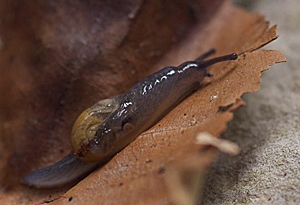
Ear-shaped glass snail (Eucobresia diaphana).
Picture: © Stefan Haller (schneckenfoto.ch).
The name glass snails is due to the glassy translucent and fragile shell of those small snails (their body size is less than 20 mm). Several native glass snail species mostly live on the ground in sufficiently humid and cool places, below decaying leaves and moss, near springs and at the side of creeks, in the mountains also in high altitudes. Glass snails only appear above ground when the weather becomes colder and wet during autumn. They remain active during the winter and even can be found below thawing snow. Because glass snails are so indifferent to coldness, their area of distribution reaches quite far North: It extends beyond the Arctic Circle. In the mountains there are species living in altitudes above 3000 m MSL. Many glass snail species also take profit from their resistance against coldness in feeding on other snails during their hibernation.
 Ear-shaped glass snail (Eucobresia diaphana). Picture: © Stefan Haller (schneckenfoto.ch). |
Class:
Gastropoda
![]() Subclass:
Pulmonata
Subclass:
Pulmonata
![]() Superorder:
Eupulmonata
Superorder:
Eupulmonata
![]() Order:
Stylommatophora
Order:
Stylommatophora
![]() Suborder:
Sigmurethra
Suborder:
Sigmurethra
![]() Infraorder:
Arionoinei
Infraorder:
Arionoinei
![]() Superfamily:
Limacoidea
Superfamily:
Limacoidea
![]() Family:
Vitrinidae Fitzinger 1833
Family:
Vitrinidae Fitzinger 1833
![]() Source:
Mollbase on
http://www.mollbase.de/list/ and Fauna Europaea on
http://www.faunaeur.org.
Source:
Mollbase on
http://www.mollbase.de/list/ and Fauna Europaea on
http://www.faunaeur.org.
The diaphanous shell of a glass snail already shows their strong similarity with a slug. Comparing for example a pellucid glass snail (Vitrina pellucida) and an ear-shaped glass snail (Eucobresia diaphana), it is obvious that while the pellucid glass snail still has a shell in which it is able to withdraw, the ear-shaped glass snail, hence its name, has a relatively smaller shell with less whorls, the last of which is widened in an ear-shape. And the snail is not able to withdraw into its shell.
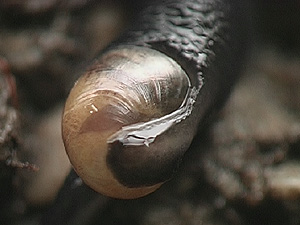 Mantle flap of Eucobresia diaphana. Picture: Andreas Heidl. |
Differences can also be seen in the shape of the mantle: From the pellucid glass snail over to other glass snail species it can be seen that the mantle shield to a growing extent covers the shell from the front. Additionally a mantle flap covers the shell spire. In some species the shell may nearly be covered completely by the mantle.
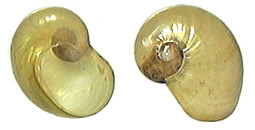 Alpine glass snail (Eucobresia nivalis). Picture: Helmut Nisters. |
This development is best visible in the Plutoniinae subfamily on the island of Madeira. So the species Plutonia marcida resembles externally to Vitrina pellucida, in having a well preserved and coiled shell. On the other hand, Plutonia albipalliata has a shell already covered to a larger extent by the mantle. In Plutonia nitida even more, and in Plutonia ruivensis and Plutonia behnii the shell is not visible anymore from outside. Superficially, this snail is now a slug.
![]() Groh,
K.; Rähle, W.; Kittel,
K.; Hemmen, J.; Bank,
R. (2009): Corrections and Additions to Mary B. Seddon's "The Landsnails of
Madeira". Conchylia 40, (3/4), 2 - 25.
Groh,
K.; Rähle, W.; Kittel,
K.; Hemmen, J.; Bank,
R. (2009): Corrections and Additions to Mary B. Seddon's "The Landsnails of
Madeira". Conchylia 40, (3/4), 2 - 25.
A similar situation can be seen in other snail groups, such as the tropical Helicarionidae family.
During the evolution of gastropods, slugs have developed several times and in different ways. The evolutionary path of reducing the shell, though, is called vitrinisation, after the glass snail family (Vitrinidae), which, however, only took one possible path of this strategy.
![]() More about
slugs.
More about
slugs.
![]() Relatives of glass snails (Vitrinoidea).
Relatives of glass snails (Vitrinoidea).
![]() Shell Reduction in Other Snail Groups.
Shell Reduction in Other Snail Groups.
Pellucid Glass Snail - Vitrina pellucida (O. F. Müller, 1774)
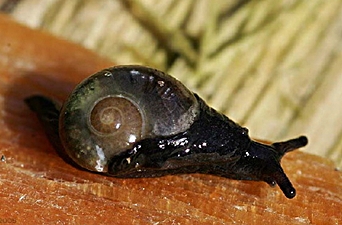 Pellucid glass snail (Vitrina pellucida). Picture: Ulla Nebel, Natur im Detail. |
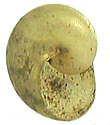 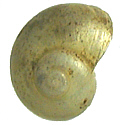 Pellucid glass snail (Vitrina pellucida) Picture: Helmut Nisters. |
Description: The pellucid glass snails has a glossy and smooth shell, whose apertural whorl is not wider than half the shell width (looking at the shell tip). The shell's whorls are rounded at the outside and the snail can withdraw completely into its shell. The mantle shield is narrow and the black mantle flap does not cover the shell tip.
Dimensions: L: 4 - 6 mm; W: 2.5 - 3.5 mm; Body length: 10 mm. (Abbreviations).
Habitat and Distribution: The pellucid glass snail in general lives in relatively open grassy habitats, in humid, but also dry, places in deciduous and coniferous forests, meadows and fallow land. It is very adaptable to changing ecological conditions. Vitrina pellucida can also be found on rocks and on walls, in the rubble of creeks, in riverside vegetation and even on Alpine meadows. In large numbers it sometimes occurs in places with little vegetation cover and even tolerates acid based ground types.
This species' distribution area spreads from Europe to Central Asia, in the North even beyond the Arctic Circle. In Switzerland, Vitrina pellucida may be encountered in an altitude of up to 2700 m MSL.
![]() Francisco Welter-Schultes:
Vitrina pellucida species homepage.
Francisco Welter-Schultes:
Vitrina pellucida species homepage.
Ear Shaped Glass Snail - Eucobresia diaphana (Draparnaud, 1805)
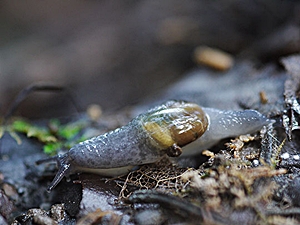 Ear-shaped glass snail (Eucobresia diaphana). Picture: © Stefan Haller (schneckenfoto.ch). |
Description: In contrary to its formerly mentioned relative, the ear shaped glass snail has a flat shell with find whitish stripes, which at least has more than two whorls. The apertural whorl is widened greatly to an ear shape. The shell spindle (columella) is curved so that the former whorls can be seen in the aperture. The animal itself is dark coloured, changing to light grey with higher altitudes. It is unable to withdraw into its shell. The mantle flap covers the shell tip (apex) completely. Anatomical characters of the genital apparatus are needed to tell this species apart from Eucobresia pegorarii.
![]() Picture of
Eucobresia diaphana by Stefan Haller.
Picture of
Eucobresia diaphana by Stefan Haller.
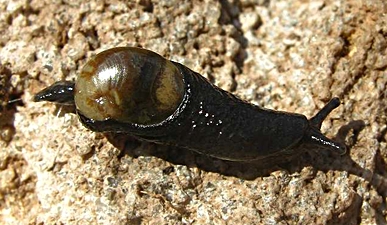 Ear-shaped glass snail (Eucobresia diaphana). Picture: Martin Albers (Source). |
Dimensions: L: 6 - 6.5 mm; W: 3.3 mm; Body length: 16 - 18 mm. (Abbreviations).
Habitat and Distribution: The ear shaped glass snail lives in humid and cool places in valleys and on mountains. In the lowlands, Eucobresia diaphana is found in shady and humid places in the forest, in higher altitudes it may also be encountered in open places, between dwarf shrubs and on grassland with sufficient possibilities to hide.
Eucobresia diaphana is found in Europe from the Pyrenees to the Balkan peninsula and as far as Northern Germany, the south-eastern Netherlands and predominantly in the Alps. In Switzerland this species is found in altitudes of up to 2900 m MSL.
Threat
Situation: In Rhineland-Palatinate Eucobresia diaphana is classified
as vulnerable (VU) (see also: ![]() IUCN Threat Categories).
IUCN Threat Categories).
![]() Francisco Welter-Schultes:
Eucobresia diaphana species homepage.
Francisco Welter-Schultes:
Eucobresia diaphana species homepage.
Mountain Glass Snail - Semilimax kotulae (Westerlund 1883)
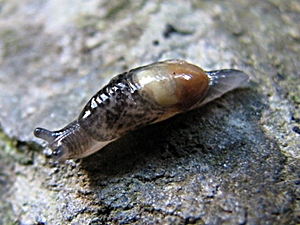 Mountain glass snail (Semilimax kotulae). Picture: Gianbattista Nardi. |
Description: The shell of Semilimax kotulae (literally half Limax) is recognized by a very elate apertural whorl. The aperture wall widens to the outside, so the inner whorls become visible. The singular whorls are flat, the shell is glossier and smoother than in other Semilimax species.
According to Ehrmann (1956), of all native glass snail species, the mountain glass snail "has progressed farthest on the way to being a slug".
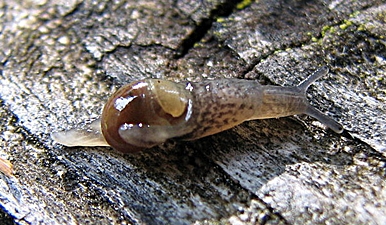 Mountain glass snail (Semilimax kotulae). Picture: Gianbattista Nardi. |
Dimensions: L: 4 - 6 mm; W: 3 - 4.5 mm; Body length: 12 - 15 mm. (Abbreviations).
Habitat and Distribution: The mountain glass snail, as its name states, only lives in mountains. It is mainly found in forests, where it lives in cool and shady places in humid moss, on stones and in the leaf litter. Only rarely it appears beyond the tree line and then it lives in humid mossy shrubs, as well as under stones on Alpine meadows.
Semilimax kotulae appears in the Alps and in the Carpathians, in Switzerland the species only occurs between 1300 and 2600 m MSL.
Threat
Situation : The mountain glass snail is rare and only occurs in a disperse
manner. It is endangered (EN) in Bavaria and classified vulnerable (VU) in
Austria (see also: ![]() IUCN Threat Categories).
IUCN Threat Categories).
![]() Francisco Welter-Schultes:
Semilimax kotulae species homepage.
Francisco Welter-Schultes:
Semilimax kotulae species homepage.
![]() Nardi,
G.; Niero, I.; Braccia,
A. (2007): Nota sui Vitrinidae (Gastropoda, Pulmonata) viventi in provincia di
Brescia. Natura Bresciana 35 (2007), 101 - 119.
Nardi,
G.; Niero, I.; Braccia,
A. (2007): Nota sui Vitrinidae (Gastropoda, Pulmonata) viventi in provincia di
Brescia. Natura Bresciana 35 (2007), 101 - 119.
Complete species list for the United Kingdom and Ireland:
According to
Anderson, R. (2008): "An annotated list of the non-marine Mollusca of Britain and
Ireland" (PDF).
Vitrinidae Fitzinger 1833
Semilimax Stabile 1859
Semilimax pyrenaicus (A. Férussac 1821) *)
Vitrina Draparnaud 1801
Vitrina pellucida (O.F. Müller 1774)
Phenacolimax Stabile 1859
Phenacolimax major (A. Férussac 1807) **)
_____________________________
*) Ireland only.
**) United Kingdom only.
 With pictures by Stefan Haller: http://www.schneckenfoto.ch. |